Hitches and Towing 101
| CHAPTER CONTENTS | |
| 1. Introduction to Towing | 7. Brake Controls |
| 2. Towing Components | 8. Hitch Installation |
| 3. Types of Hitches | 9. Hooking Up |
| 4. Determining Tow Capacity | 10. Tow Bars/Dinghy Towing |
| 5. Selecting Your Hitch | 11. Towing Safety |
| 6. Wiring/Electrical | 12. Preparing Your Tow Vehicle |
Chapter 10
- Tow Bars/Dinghy Towing
One of
the most common towing situations in the United States involves flat-towing a
small car or SUV behind an RV. For those lucky permanent road warriors, pulling
a small car allows them to set up camp virtually anywhere and use the towed car
for local jaunts to tourist attractions and to run necessary errands.
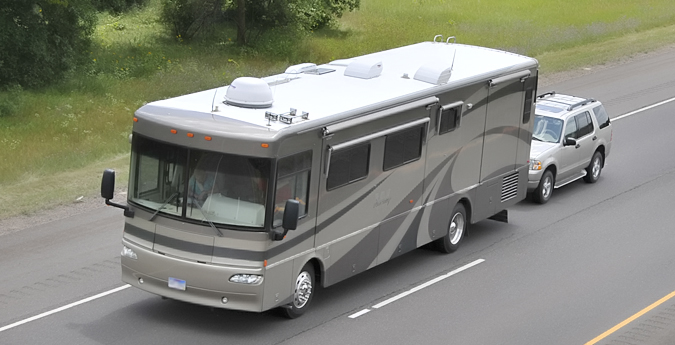
This kind of towing is called "dinghy towing," named after the way
yachts haul small transit boats in their wake. Dinghy towing has
claimed such a big share of the towing scene that a whole line of specialized
equipment has been developed to support the practice, including light wiring,
supplemental brake actuators for towed vehicles, supplemental transmission
lubrication pumps, and quick disconnect couplings for the driveshaft.
There are two common ways of dinghy towing: using a tow bar or a
tow dolly. A tow bar is distinguished by the fact that all four wheels
of the towed vehicle stay on the pavement. The tow bar attaches to the front
bumper area - often to special attachment points installed in the car's bumper.
There are companies that make custom tow bar brackets that attach to the vehicle
frame.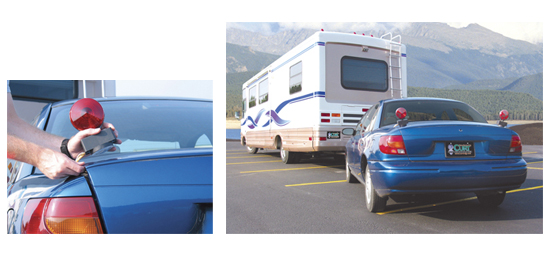
Figure
10-1: Magnetic Towing Lights
Sometimes the "trailer lights"
on a towed car are the car's existing lights, wired to respond to the towing
vehicle. But you can also purchase separate towing lights, usually with magnetic
bases, that are placed on the towed vehicle.
Using a Tow Bar
Towing with a tow bar can be a
complicated procedure. Cars aren't designed to be towed for long distances.
They're designed to drive under their own power. 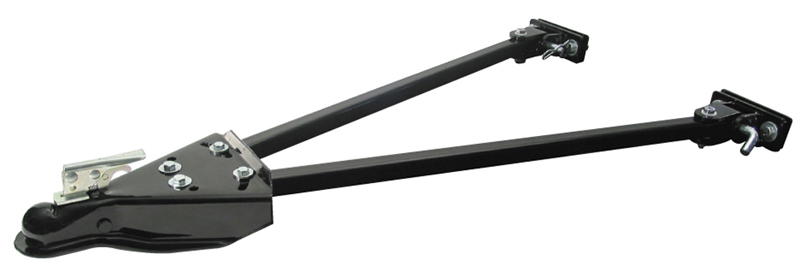
Figure
10-2: Adjustable Tow Bar
When you tow, you need to make sure that the front wheels are pointed
straight ahead, or the car will try to pull your tow vehicle one way or the
other. But many steering locks will hold the wheels slightly off dead center. So
when towing, the steering must remain unlocked, as the wheels will naturally
come back to center when in motion.
You also need to make sure that you
have followed the manufacturer's recommendations with regard to the towed car's
transmission. Transmissions are designed to be turned by the engine, and this
process pumps gear oil or automatic transmission fluid through the gearbox. When
you tow a car with its drive wheels (front or rear) on the pavement, the wheels
turn the transmission and in some designs, this can lead to transmission
damage.
One reason why 4WD vehicles such as Jeeps have been popular
as towed vehicles is that the 4WD mechanism includes a transfer case that can be
placed in neutral, isolating the transmission from the wheels. Front wheel drive
cars with manual transmissions are also a good bet. Your car's owner's manual
will tell you if it can be safely flat-towed.
Your best bet for
flat-towing is to consult your RV or trailer center. They will have the most
current information on products, legal requirements, and the suitability of your
towed vehicle.
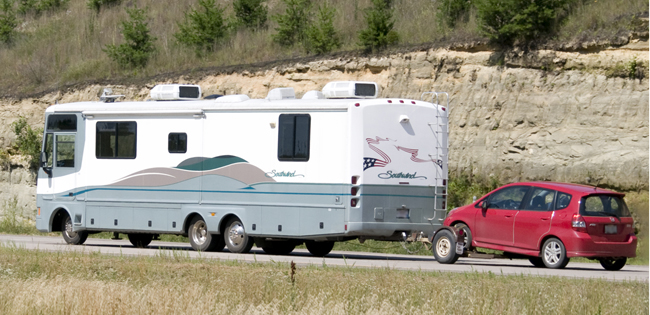
Tow Dollies
Another option for towing a car behind an
RV is to use a tow dolly. These are most commonly found at RV dealers for
purchase or at trailer rental services. These mini-trailers have two
wheels of their own and cradle the front wheels of the towed vehicle. they have
their own trailer lights (or magnetic lights) attached.
Downsides of
using a tow dolly for long distances include uneven tire wear and occasionally,
braking difficulties if the towing vehicle is not substantially larger and
heaver than the towed vehicle. All the same procedures, measurements, and
cautions or trailer towing apply to a tow dolly.
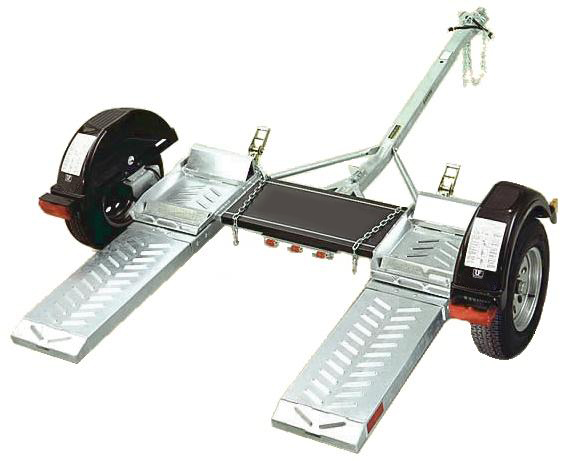
Figure
10-3: Tow Dolly
The Bottom Line on Dinghy Towing
Dinghy towing has
gotten easier, safer, and more popular in the last 20 years, and will remain a
mainstay of towing in general and RV towing in particular. As an old-school
purist, I prefer to use a flatbed or car-hauler trailer for ease of connection
and safe towing, but I pay the price in added weight. The important thing is to
get the right equipment for your towing plans and to know how to use it
properly.
DO
- Consult your vehicle's owner's manual before flat-towing
- Use safety cables at all times
- Leave generous stopping distance
- Use clearly visible trailer lights
- Familiarize yourself with and adhere to all applicable state and local regulations.
DON'T
- Assume you can flat-tow any car
- Tow without complete legal safety gear
- Flat-tow above the posted speed limit
| << Back to Chapter 9 | Go to Chapter 11 >> |




